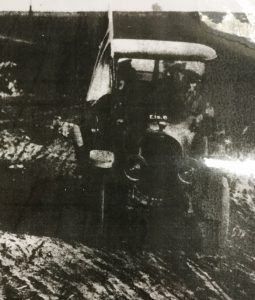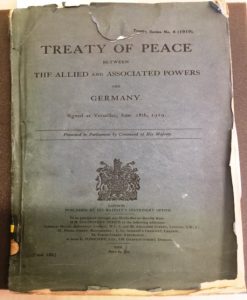Follow the Drum: a reflection [Part 1] – Post-hostilities
Guerre Finie! Boche Napoo!
A grainy image of a German car emerging from the mirk of a battlefield caught my imagination as I was researching this last piece for the Follow the Drum 2014-18 blog. It was in the Illustrated London News amongst the reports about the final stages of the conflict. Before considering the impact of the final stages of the First World War on the local community it is worthwhile considering some aspects of the general context.

Studying the image, you can see the white flag hanging from one side of the vehicle and the blurred yet strained faces of four German Officers within, one officer driving. They passed through British lines (the location was undisclosed) on their mission.
Sent to reveal the whereabouts of all the mines they had laid, as well as any delayed fuses disposed on that territory: what did those officers think at that moment? How did they feel about the situation? We can only imagine what they experienced as they passed through the now silent previous sites of battle.
Under penalty of reprisals, these former enemy combatants were being obliged to fully disclose any other destructive measures such as poisoning wells and springs. They drove on through the Canadian lines.
Though the war had been industrialised and new technologies were introduced there was as yet no such thing as mine detectors. The German Officers were relying on information from their engineers.
This historic moment represented a visible sign of how the eighth clause of the Armistice terms was being enforced.
It was a delicate choreography that highlighted tensions and resentments. As events unfolded there were surrenders on various fronts of different forces (on the land, in the air and on the sea).
The editorial in the Illustrated London Evening News by G. K Chesterton in 1918 provides a useful perspective on the peace process:
Men began it; men ended it; but fortunately those who ended it were not those who began it… And the last phase of it was not only the most strenuous, but the most simple phase… The war did not end; it was ended, because there is in the heart of man that cleaner creative hope that can endure and can end them.
History was in the making: it was peace at last albeit in grim surroundings and at an immense cost.
Ending the war at sea

One example of a nationally significant moment for Britain was the cessation of hostilities at sea. Conditions had been outlined during the Armistice negotiations (November 1918) and subsequently formed the basis of part of the Treaty of Versailles (June 1919).
Rum and Fireworks
For the British Navy on the November 11 1918 at 7 pm a special rum ration was served. At 8 pm all ships were lit up and sirens sounded. Searchlight beams criss-crossed, there were flares, fireworks and star-shells for an hour. Then all silent and unlit again save a twinkle signalled from the Admiral’s ship gave the orders to carry on. (Illustrated London Evening News November 1918).
Meanwhile, tensions were apparent for the German Navy on surrender (Illustrated London News, November 30 1918). It was reported that men were lounging about smoking in the presence of officers on the Battleship Markgraf. There were representatives of the new Socialist regime present wearing armlets (members of the Workers & Soldiers Council) overseeing proceedings.
The captive high seas fleet anchored off Inchkeith and 4 British officers conveyed general orders regarding procedure to Admiral von Reuter (onboard battleship ‘Friedrich der Grosse’) sent by Admiral Sir George Madden. Relations were strictly formal and all conversations were forbidden except in regard of the immediate business to be transacted.
The German flag was carried for the last time and could not be hoisted again without permission. A British dirigible N. S. S. flew overhead and when receiving the German fleet British Gunners were on action stations. German battleships, battle-cruisers and light cruisers were all now interned. The British retained their status as the dominant naval force once again as simultaneously the naval blockade of Germany continued.
Follow the Drum ‘encore’
Part 2 of this article will follow the lives and events that involved the local community after the ending of the First World War 100 years ago.
Themes to be covered include war trophies, local peace celebrations, social change, reconstruction, employment and the Spanish flu.
Follow the Drum 2014-18 is a four year long project about the impact of war in Richmond upon Thames. Read previous posts.
Workshop
This post is based on my presentation held Richmond upon Thames Local Studies Library & Archive in September 2018
I will also be presenting this ‘Follow the Drum 2014-18’ workshop for the final time as part of Explore Your Archive week on Friday 23 November 2018 from 2.30 pm – 3.30 pm Book Online
Bibliography
Treaty of Peace between the Allied and Associated Powers and Germany.
Mr Punch’s History of the Great War.
The First World War: A Very Short Introduction
[Patricia Moloney, Local Studies Assistant]
